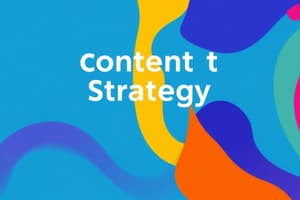Podcast
Questions and Answers
What is a key element of an effective homepage for an e-commerce site?
What is a key element of an effective homepage for an e-commerce site?
- Hero section with high-quality images (correct)
- User login prompt
- Link to social media accounts
- Single product spotlight
Which of the following is NOT a best practice for designing product pages?
Which of the following is NOT a best practice for designing product pages?
- Adding customer reviews
- Including high-resolution images
- Providing clear pricing information
- Offering a complex checkout process (correct)
What should be included in the footer of an e-commerce website?
What should be included in the footer of an e-commerce website?
- Links to social media
- Links to important pages like Contact and Privacy Policy (correct)
- Current promotions and sales
- Navigation to product categories
Why is a clear and intuitive website layout important for e-commerce sites?
Why is a clear and intuitive website layout important for e-commerce sites?
What is a recommended feature in the checkout process to reduce cart abandonment?
What is a recommended feature in the checkout process to reduce cart abandonment?
What is the primary aim of responsive design in e-commerce?
What is the primary aim of responsive design in e-commerce?
Which element is NOT a key component of search engine optimization (SEO)?
Which element is NOT a key component of search engine optimization (SEO)?
Which technique is utilized to apply different styles based on a device's characteristics in responsive design?
Which technique is utilized to apply different styles based on a device's characteristics in responsive design?
What distinguishes UX design from UI design?
What distinguishes UX design from UI design?
Which of the following tools is specifically used for analyzing user experience performance?
Which of the following tools is specifically used for analyzing user experience performance?
Which element is crucial for creating a user-friendly UI design?
Which element is crucial for creating a user-friendly UI design?
What is a key benefit of having a well-planned content strategy?
What is a key benefit of having a well-planned content strategy?
Which approach should be emphasized in product descriptions?
Which approach should be emphasized in product descriptions?
What aspect is essential when creating high-quality product images?
What aspect is essential when creating high-quality product images?
What is an effective way to improve readability in product descriptions?
What is an effective way to improve readability in product descriptions?
Flashcards
Website Header
Website Header
The top part of a website containing essential elements like the logo, search bar, and navigation menu.
Main Navigation
Main Navigation
A key element of a website that helps users easily navigate between different content areas or product categories.
Website Footer
Website Footer
The section at the bottom of a website that often includes links to important pages like contact, privacy policy, and about us.
Homepage
Homepage
Signup and view all the flashcards
Product Pages
Product Pages
Signup and view all the flashcards
Responsive Design
Responsive Design
Signup and view all the flashcards
Search Engine Optimization (SEO)
Search Engine Optimization (SEO)
Signup and view all the flashcards
User Experience (UX) Design
User Experience (UX) Design
Signup and view all the flashcards
Keyword Research
Keyword Research
Signup and view all the flashcards
Technical SEO
Technical SEO
Signup and view all the flashcards
UI Design
UI Design
Signup and view all the flashcards
Content Strategy
Content Strategy
Signup and view all the flashcards
Product Descriptions
Product Descriptions
Signup and view all the flashcards
High-Quality Product Images
High-Quality Product Images
Signup and view all the flashcards
Color Scheme in UI Design
Color Scheme in UI Design
Signup and view all the flashcards
Study Notes
Website Layout and Navigation
- A clear and intuitive layout helps users easily find what they need for a better shopping experience.
- Key elements include a header (logo, search bar, navigation menu), clear main and subcategories in the navigation, and a footer with links to important pages (Contact, About Us, Privacy Policy).
- Consistent layout across all pages, breadcrumbs for easy navigation, and a well-organized menu are best practices.
Designing the Homepage
- The homepage acts as the gateway to the online store, setting the tone and directing users to different sections.
- Key elements involve a hero section with high-quality images or videos often with a call to action, product highlights (featured products, bestsellers, new arrivals), promotional banners for sales, discounts, or special offers, and clear navigation to the shop, categories, or other key areas.
- Best practices include keeping the homepage visually appealing, ensuring quick load times, and creating intuitive navigation.
Designing Product Pages
- Product pages provide detailed information about each item, crucial for converting visitors into buyers.
- Key elements include high-resolution images from multiple angles with zoom functionality, a clear and convincing product description highlighting key features and benefits, pricing information (including discounts or promotions), prominent "Add to Cart" or "Buy Now" buttons, and customer reviews for social proof.
- Best practices include creating a mobile-friendly page, incorporating relevant keywords for SEO, and providing a smooth checkout process.
The Checkout Process
- The checkout process is where conversions happen. Any friction can lead to cart abandonment.
- Steps in the checkout process include a shopping cart allowing users to review, update quantities, and see the total cost.
- Other key steps are guest checkout options, multiple secure payment methods, and order confirmation with a summary and confirmation message or email.
- Best practices emphasize simplifying the checkout process, minimizing steps, and ensuring mobile-friendliness.
Mobile Commerce and Responsive Design
- Responsive design adapts websites to different screen sizes (desktops, tablets, smartphones) for optimal viewing.
- Mobile-friendly e-commerce sites are crucial due to increasing mobile device use for shopping.
- Key elements of responsive design include fluid grids (flexible layouts), flexible images that scale, and media queries for applying different styles based on device characteristics.
- Benefits include improved user experience, higher mobile conversion rates, and better SEO ranking.
Search Engine Optimization (SEO)
- SEO optimizes a website to rank higher in search engine results and drive organic traffic.
- Key elements include keyword research to identify relevant terms, on-page SEO (optimizing title tags, meta descriptions, headers, and content), technical SEO (improving site crawlability and indexability), content marketing (creating valuable content), and off-page SEO (building backlinks and engaging with social media).
- SEO tools such as Google Analytics, SEMrush, and Ahrefs help in monitoring and improving performance.
User Experience (UX) Design
- UX design focuses on creating a seamless and enjoyable user experience, ensuring the website is easy to use and meets user needs.
- Key elements include usability (ease of completing tasks like finding a product or making a purchase), accessibility (site accessibility for users with disabilities), performance (fast load times and smooth navigation), and feedback (confirmation messages or error alerts for user actions).
- UI vs. UX, while UI focuses on the website's aesthetics, UX is about the broader user experience.
User Interface (UI) Design
- UI design involves the look and feel of the website including visual design, layout, and interactive elements.
- Key elements include a color scheme consistent with the brand and evoking desired emotions, readable and consistent typography, intuitive and visually appealing icons and buttons that guide users, and a consistent design across all pages to create a cohesive experience.
- Best practices include keeping the design clean, avoiding clutter, and prioritizing a user-friendly interface.
Content Strategy
- Content strategy plans, creates, and manages content that engages users and drives conversions.
- Types of content include product descriptions (clear and persuasive highlighting benefits), informative blogs and articles (improving SEO), product demos and tutorials (videos), and user-generated content (customer reviews and photos).
- Benefits include improved SEO, increased engagement, improved conversion rates, and enhanced brand loyalty.
Optimizing Product Descriptions
- Product descriptions should inform, persuade, and convince users to purchase the product.
- Key elements include highlighting both product features and benefits, incorporating relevant keywords for SEO, reflecting the brand's personality and voice, and making the description easy to read through use of bullet points, short sentences, and headings.
Creating High-Quality Product Images
- High-quality images are crucial in online shopping as they are the only interaction users have with a product.
- Key elements include multiple angles showcasing the product from different perspectives, zoom features allowing users to view the product up close, lifestyle images showing the product in use, and consistent image quality across the entire site.
- Using tools like Photoshop, Canva, and Adobe Lightroom can improve the design.
Implementing Customer Reviews and Ratings
- Customer reviews and ratings act as social proof, building trust and influencing purchase decisions.
- Key features include star ratings (simple visual rating system), written reviews providing detailed product feedback, verified purchases to show credibility, and review responses to address concerns.
- Best practices include encouraging reviews, regularly monitoring and managing reviews, and displaying positive feedback prominently.
Personalization and Recommendations
- Personalization tailors the shopping experience to individual user preferences to increase engagement and sales.
- Key techniques include product recommendations based on browsing history, past purchases, or similar user behavior, personalized content, and dynamic pricing adjusting prices based on user behavior, demand, or location.
- Personalization tools like Dynamic Yield and Nosto are examples of AI-driven personalization.
Integrating Social Media with E-Commerce
- Social media integration lets users directly engage with a brand and products.
- Key features include social sharing buttons for users to share products on various platforms, social proof displaying social media posts related to products, social login allowing users to log in using social accounts, and shoppable posts directly selling products on social media channels like Instagram and Facebook.
Managing Inventory and Product Listings
- Efficient inventory management ensures accurate stock levels and availability for purchase.
- Key features include real-time inventory updates automatically updating stock levels, product variations managing different product versions, backorders and pre-orders allowing purchase of out-of-stock products later, and automated reordering setting up automated reorders when stocks reach a certain threshold.
- Using inventory management systems such as TradeGecko and NetSuite can help with the process.
Implementing Security Measures
- Security is crucial in e-commerce for protecting sensitive customer data and building trust.
- Key measures include SSL certificates for encrypted connections, two-factor authentication adding an extra layer of security, and regular security audits to identify and fix vulnerabilities.
- Adhering to regulations like GDPR and CCPA is also essential.
Setting Up Shipping and Fulfillment
- Efficient shipping and fulfillment processes are critical for customer satisfaction and repeat business.
- Shipping options include flat-rate shipping (same rate for all orders), real-time carrier rates (accurate costs based on location and weight), and free shipping (often with minimum order threshold).
- Fulfillment options can be in-house, using a third-party logistics (3PL) provider, or using dropshipping.
Understanding Legal and Compliance Requirements
- Complying with legal regulations protects a business and customers.
- Key areas include privacy policies clearly explaining data collection, use, and protection, terms and conditions outlining website rules and responsibilities, consumer protection laws, and compliance with sales tax laws in different regions.
- Best practices emphasize regularly reviewing legal documents for compliance.
Testing and Launching the Website
- Thorough testing is crucial for ensuring site functionality and user experience before going live.
- Key testing areas include functionality testing ensuring all features work accurately, performance testing analyzing speed and load times, security testing finding and fixing vulnerabilities, and user acceptance testing allowing real users to provide feedback.
- Planning the launch including marketing and traffic monitoring is important.
Post-Launch Monitoring and Optimization
- Continuous monitoring and optimization ensure a website remains effective and relevant.
- Key activities include analytics monitoring, performance optimization, updating content, and collecting user feedback to make adjustments.
- Using tools like Google Analytics, Hotjar, and A/B testing tools supports this process.
Studying That Suits You
Use AI to generate personalized quizzes and flashcards to suit your learning preferences.




